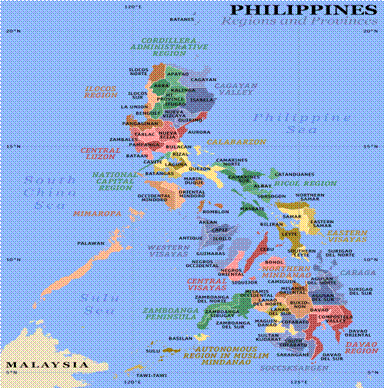
Index Introduction Structure Countryprofiles Topics Links Comments
The Republic of the Philippines is a constitutional democracy, with the President as head of state. The President and Vice President are elected by the people for six-year terms. The national government has three coequal branches that exercise a system of checks and balances: executive, legislative, and judicial.
The executive branch consists of the President and his Cabinet. The Senate and the House of Representatives make up the bicameral legislature. The Supreme Court heads the systems of courts under the judicial branch.
Congress consists of a 24-member Senate and a 250-member House of Representatives. The voters of the entire nation elect senators to six-year terms. Voters from different districts elect 200 of the representatives to three-year terms. The remaining 50 representatives are selected from lists drawn up by the political parties to ensure representation of women, ethnic minorities, and certain economic and occupational groups. The number selected from each party's list is about one-fourth of the number of the party's elected representatives. All Philippine citizens who are at least 18 years old may vote.
The Philippine Constitution is the fundamental basis of the laws of the land. The country has had several Constitutions, but the current one was adopted through a nationwide plebiscite in 1987. It is supported by other laws, such as the Civil Code, the Labor Code, the Omnibus Investments Code, and the National Internal Revenue Code, as well as by rules and regulations passed by government bodies. The latter include rulings, letters of instruction, circulars, memoranda, administrative orders, judicial orders, and pronouncements, as well as laws adopted by local government within the scope of the Constitution.
The Philippines, officially known as the Republic of the Philippines, is a country in Southeast Asia with Manila as its capital city. It comprises 7,107 islands in the western Pacific Ocean.
The Philippines is the world's 12th most populous country, with a population of about 90 million people. Its national economy is the 45th largest in the world, with an estimated 2008 gross domestic product (GDP) of over US$ 168.6 billion (nominal). There are more than 11 million overseas Filipinos worldwide, estimate about 11% of the population.
A former colony of Spain, and the United States, the Philippines is one of two predominant Roman Catholic countries in Asia, the other being East Timor. There are also a number of minority religious groups, including Islam, Buddhism, Hinduism, and other beliefs. Multiple ethnicities and cultures are found throughout the islands. Ecologically, the Philippines is one of the most diverse countries in the world.
The Philippines is divided into three island groups: Luzon, Visayas, and Mindanao. These are divided into 17 regions, 80 provinces, 120 cities, 1,511 municipalities, and 42,008 barangays.

The climate of the Philippines is a tropical marine climate dominated by a rainy season, dry season and a cool season that dominates on November to Mid-February. The summer monsoon brings heavy rains to most of the archipelago from May to October, whereas the winter monsoon brings cooler and drier air from December to February. Manila and most of the lowland areas are hot and dusty from March to May. Even at this time, however, temperatures rarely rise above 37 °C (99 °F). Mean annual sea-level temperatures rarely fall below 27 °C (81 °F). Annual average rainfall ranges from as much as 5,000 millimetres (200 in) in the mountainous east coast section of the country to less than 1,000 millimetres (39 in) in some of the sheltered valleys. Monsoon rains, although hard and drenching, are not normally associated with high winds and waves. But the Philippines sit astride the typhoon belt, and the country suffers an annual onslaught of dangerous storms from July through October. These are especially hazardous for northern and eastern Luzon and the Bicol and Eastern Visayas regions, but Manila gets devastated periodically as well.
TABLE 1: POPULATION INFORMATION
| Average Annual Growth Rate (%) | ||||||||
| 1970 | 1980 | 1990 | 2000 | 2005 | 2007 | 2009 | 2000 - 2009 | |
| Population (Millions) | 36.6 | 48.1 | 60.7 | 76.9 | 85.3 | 88.57 | 92.2 | 2.21 |
| Population Density (Inhabitants/km2) | 121.8 | 160.3 | 203.2 | 254.5 | 284.2 | 295.2 | 307.3 | 2.31 |
| Urban Population as % of Total | 31.8 | 37.5 | 47.0 | 48.1 | 63.0 | 64.2 | 65.7 | 1.96 |
| Area (1000 km2) | 300 000.0 | |||||||
SOURCE: World Development Indicators Database, World Bank; www.gfmag.com; www.doe.gov.ph/energystatics/
| TABLE 2: GROSS DOMESTIC PRODUCT | Average Annual Growth Rate (%) |
| 1970 | 1980 | 1990 | 2000 | 2005 | 2007 | 2009 | 2000 - 2009 | |
| GDP (Millions of Current US$) | 6,687 | 32,450 | 44,312 | 75,913 | 98,824 | 144,062 | 161,196 | 12.48 |
| GDP (Millions of Constant 2000 US$) | 26 774 | 47,575 | 56,230 | 75,913 | 94,446 | 2.71** | ||
| GDP Per Capita (PPP* US$/Capita) | - | 1,249 | 1,750 | 2,333 | 2,959 | 3,406 | 5.11 | |
| GDP Per Capita (Current US$/Capita) | 183 | 675 | 724 | 996 | 1 167 | 1 639 | 1,752 | 8.43 |
* purchasing power parity
** average annual growth rate from 2000 to 2005
SOURCE: World Development Indicators Database, World Bank; www.gfmag.com; Earth Trends Country Profile
TABLE 3: ESTIMATED AVAILABLE ENERGY RESOURCES
| Fossil Fuels | Nuclear | Renewables | ||||
| Solid | Liquid | Gas | Uranium | Hydro | Other Renewable | |
| Total Amount in Specific Units* | 324 MMT @ 10,000 BTU/lb |
277 MBbl @ 18,500BTU/lb |
3,808BCF @ 49.5MJ/kg |
- | 9,788 GWh | 80 GWh |
| Total Amount in Exajoules [EJ] | 7.531 | 1.515 | 4.271 | - | 0.0352 | 0.0003 |
TABLE 4: ENERGY STATISTICS
| ENERGY CONSUMPTION/SUPPLY | Average Annual Growth Rate (%) | |||||
| 1990 | 2000 | 2005 | 2007 | 2009 | 2000 - 2009 | |
| TOTAL, MTOE | 39.3 | 38.5 | 38.9 | 39.6 | 0.4 | |
| - Solids, MMT at 10000 BTU/lb | 8.762 | 10.075 | 10.215 | 11.494 | 6.0 | |
| - Liquids, MBbl | 103.87 | 98.45 | 96.48 | 96.25 | -1.1 | |
| - Gases, MSCF | 376 | 115 966 | 130 210 | 138 029 | 52 | |
| - Nuclear | - | - | - | - | - | |
| - Hydro, MWh | 7 799 | 8 387 | 8 563 | 9 787 | 7.0 | |
| - Other Renewables, MWh | 11 317 | 9 921 | 10 274 | 10 403 | 0.07 | |
| ENERGY PRODUCTION | 1990 | 2000 | 2005 | 2007 | 2009 | 2000 - 2009 |
| TOTAL, MTOE | 19.3 | 21.2 | 22.0 | 23.5 | 2.4 | |
| - Solids, MMT at 10,000 BTU/lb | 1.353 | 3.164 | 3.737 | 5.176 | 16 | |
| - Liquids, MBbl | 0.42 | 5.79 | 5.93 | 8.38 | 43 | |
| - Gases, MSCF | 376 | 115 966 | 130 211 | 138 030 | 52 | |
| - Nuclear | 0 | 0 | 0 | 0 | 0 | |
| - Hydro,MWh | 7 799 | 8 387 | 8 563 | 9 787 | ||
| - Other Renewables, MWh | 11 317 | 9 921 | 10 274 | 10 403 | 0.07 | |
| NET IMPORT (IMP - EXP) | 1990 | 2000 | 2005 | 2007 | 2009 | 2000 - 2009 |
| TOTAL, MTOE | - | 19.9 | 17.3 | 16.9 | 16.2 | -1.9 |
AAGR – average annual growth rate (%)
KTOE: kiloton oil equivalent, MTOE: millionton oil equivalent, MSCF: million std cubic ft.
MMT: million metric ton, MBbl: million barrels, BCF: billion cu.ft
SOURCE: Energy Statistics, Dept. of Energy
The energy policy reflects the state’s commitments to pursue the energy independence agenda under the government’s Five-Point Reform Program Package as shown in the proceeding diagram. The first objective is anchored on the effective implementation of the following goals: (a) accelerating exploration; development and utilization of indigenous energy resources; (b) intensifying renewable energy resource development; (c) increasing the use of alternative fuels; and, (d) enhancing energy efficiency and conservation. On the other hand, the continuing reforms in the power sector as well as the downstream oil and gas industries will pave the way in realizing a globally competitive Philippine energy sector.
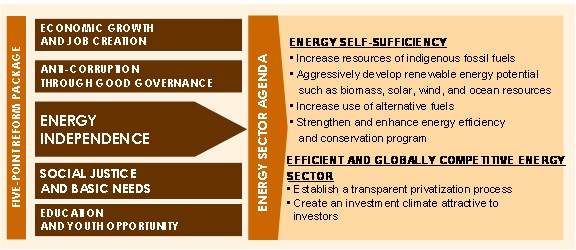
The Philippine Department of Energy sets overall policy goals in the energy industry, while the Energy Regulatory Commission is charged with regulating the electricity sector. After experiencing a severe power crisis in the early 1990s, the Philippine government set out to restructure and privatize the power sector with the aim of ensuring adequate electricity supply and increasing investment in energy infrastructure. After several years of legislative debate, the Republic Act 9136 or the Electric Power Industry Reform Act (EPIRA) of 2001 was enacted.
EPIRA set into motion the deregulation of the power industry and the breakup and eventual privatization of state-owned enterprises. Under EPIRA, the government needs to privatize 70 percent of state-owned National Power Corporation’s generating and contracted plants before an open access regime can start in the power sector. As of present, the Power Sector Assets and Liabilities Management Corporation or PSALM (designated government corporation as liquidator of all NPC assets) had achieved an almost 70 percent privatization for power plants.
The future electric power industry will be dominated by the private sectors while the government will focus more on the missionary electrification of the off grid areas and islands.
The Philippine electric power sector maybe categorized into two (2) aspects, namely the main grid, and the off-grid.
The main grids are those within the main islands of the Philippines, Luzon, Visayas and Mindanao, while the off grids are those on the several islands which are not connected to the main grid.
In the main grids, the supply of electric power came from the government (the National Power Corporation) and several independent power producers or IPPs. As of 2008, the total installed capacities in Luzon is about 9,200 MW, in Visayas is 1,380 MW while in Mindanao, it is 1,800MW. For the off grids, there are at least 110 small power plants serving the power needs of those remote places and islands with a total combined installed capacity of 250 MW.
Transmission of energy in the main grids is under the management of a private concessionaire, the National Grid Corporation of the Philippines (NGCP). The off grids transmission is by the NPC through its Missionary Electrification Program. Distribution of power to customers was being done through electric cooperatives, private distribution utility companies and economic zones.
With the intent of the EPIRA on hand, the Wholesale Electricity Spot Market or WESM is being managed and governed by the Philippine Electricity Market Corporation where the trading of electricity is being dealt with.
TABLE 5: ELECTRICITY PRODUCTION, CONSUMPTION & CAPACITY
| Average Annual Growth Rate (%) | ||||||
| Capacity of Electrical Plants [GWe] | 1990 | 2000 | 2005 | 2007 | 2009 | 2000 - 2009 |
| TOTAL | - | 13.18 | 15.62 | 15.94 | 15.61 | 2.3 |
| - Thermal | - | 11.95 | 10.39 | 10.66 | 10.31 | 11.4 |
| - Hydro | - | 2.30 | 3.22 | 3.29 | 3.29 | 3.6 |
| - Nuclear | - | - | - | - | - | - |
| - Wind | - | - | 0.03 | 0.034 | 0.064 | 25.6 |
| - Geothermal | - | 1.93 | 1.98 | 1.96 | 1.96 | 0.1 |
| - Other Renewables | - | - | - | - | - | - |
| Electricity Production (TWh) | 1990 | 2000 | 2005 | 2007 | 2009 | 2000 - 2009 |
| TOTAL | 23.75 | 45.29 | 56.57 | 59.61 | 61.93 | 4.1 |
| - Thermal | 12.71 | 25.87 | 38.26 | 40.77 | 41.744 | |
| - Hydro | 5.80 | 7.80 | 8.39 | 8.56 | 9.84 | 2.2 |
| - Nuclear | - | - | - | - | - | - |
| - Wind | - | - | 0.02 | 0.059 | 0.079 | |
| - Geothermal | 5.24 | 11.63 | 9.90 | 10.21 | 10.32 | -0.3 |
| - Other Renewables | - | - | 0.00 | 0.00 | 0.00 | -1.87 |
| Total Electricity Consumption (TWh) | 1990 | 2000 | 2005 | 2007 | 2009 | 2000 - 2009 |
| TOTAL | - | 38.945 | 49.751 | 52.004 | 54.422 | 4.1 |
Source: Department of Energy (DOE) NPC, Power Economics Department
| 1980 | 1990 | 2000 | 2005 | 2007 | 2009 | |
| Energy Consumption Per Capita (GJ/Capita) | 22.03 | 19.42 | 18.89 | 18.47 | ||
| Electricity Consumption Per Capita (kWh/Capita) | - | 506 | 583 | 587 | 590 | |
| Electricity Production/Energy Production (%) | - | - | 19.64 | 22.33 | 22.67 | 22.05 |
| Ratio of External Dependency over Total Energy Supply (%) | - | - | 51.8 | 44.9 | 43.5 | 40.8 |
Source: Energy Statistics, Department of Energy (DOE)
The first international oil crises in late 1973 which raised the reference price of crude oil by more than five (5) times has arose the government’s view on nuclear power. Though there has been studies on the feasibility of a nuclear power way back in the ‘50s, it was only in 1974 that the Philippine government seriously considered the erection of a nuclear power plant in the Philippine grid. Hence, in February 9, 1976, the Philippine government through the National Power Corporation entered into contract with Westinghouse Electric Corporation for the turn-key construction of a 620 MWe, PWR nuclear plant on the Bataan peninsula which is the Bataan Nuclear Power Plant or BNPP. The plant was scheduled for operation in 1983, however, the accident at the Three Mile Islands nuclear power plant in the US has led the Philippine government to conduct inquiry on the design of the Westinghouse plant. This delayed the plant completion by two more years with an additional cost of US$0.9 billion.
In May 1984, the plant was fully completed and the hot functional tests of all systems were satisfactorily conducted. The 1985 IAEA OSART performed evaluation of the operational readiness of the plant and it reported that the plant could perform the core loading. However, with the change of the government in 1986, the new leadership decided not to operate the plant and placed it under long-term preservation.
The present interest in the re-operation of the BNPP was due to the volatile and soaring price of coal which fuels the 50 percent of the base load power plants in the main grid. Upon the request of the Philippine Government (DOE) through the Philippine Nuclear Research Institute (PNRI) for assistance to IAEA, a Review Mission was dispatched by the
Agency for the purpose of providing support to the Philippine Government in the study of the feasibility of rehabilitating the country’s Bataan Nuclear Power Plant (BNPP).
The IAEA Review Mission was conducted from January 28, 2008 to February 2, 2008 and among the major recommendations of the Mission were the setting-up of the national nuclear energy policy and the establishment of the dedicated nuclear core group for the nuclear power program of the country.
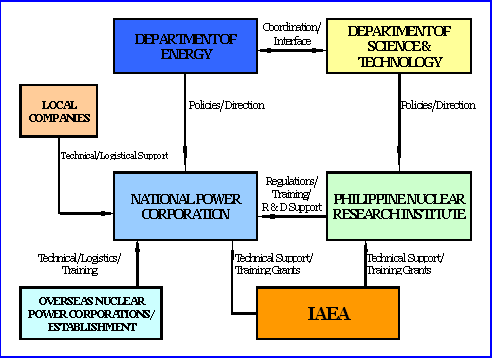
TABLE 7. STATUS AND PERFORMANCE OF NUCLEAR POWER PLANTS
| Station | Type | Net Capacity | Status | Operator | Reactor Supplier | Construction Date | Criticality Date | Grid Date | Commercial Date | Shutdown Date |
| BNPP-1 | PWR | 620 | Cancelled Constr. | RPNPC | WH | 1976-07-01 | 1986-05-01 |
* UCF (Unit Capability Factor) for the latest available year (only applicable to reactors in operation).
** Latest available data
+ Date, when first major placing of concrete, usually for the base mat of the reactor building is done.
++ Date of the first connection to the grid
Source: PRIS database (www.iaea.org/pris).
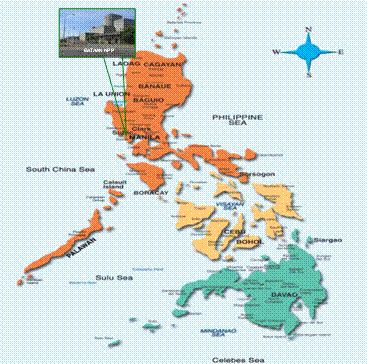 | |
The Bataan Nuclear Power Plant is under preservation since its completion in 1986. IAEA Mission has been conducted in 2008 which gave recommendations for nuclear grade preservation of the plant. Plant life “assessment” will be carried out as part of the status verification of plant systems and components.
During its construction in the ‘70s/80’s, BNPP has been issued with the corresponding Construction Permit by the regulator. This Permit may either be renewed or upgraded depending upon the result of assessment and feasibility study to be undertaken in the near future.
Since the creation of the DOE in 1992, only the Philippine Energy Plan (PEP) covering the planning period 1998-2035 incorporated nuclear as a long-term energy supply option. The 1998 Plan forecast developed four scenarios to determine its sensitivity to different energy policy alternatives and the impact of regional cooperation programs. Under the said Plan, a 600-MW nuclear plant will be operational by 2025. Additional nuclear power plant units 600 MW each were planned to be completed in 2027, 2030 and 2034.
Thus under the PEP 1998-2035, the total nuclear capacity was projected to reach 2,400 MW by the end of the planning period*.
At present, a bill for the recommissioning of the BNPP is pending on the Philippine Congress which when passed into law would hasten the nuclear program for the Philippines. Likewise the operation of the said power plant would also trigger the construction of more units.
When the BNPP recommissioning bill is approved, a feasibility for the plant’s recommissioning will be undertaken and within a period of three to five years, BNPP may be put into operation.
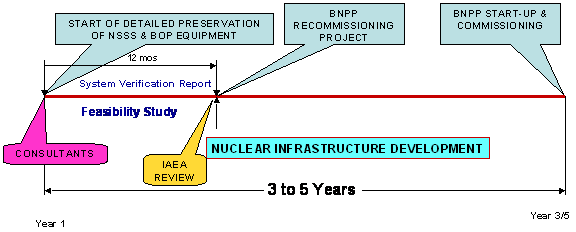 | |
The contract for the recommissioning of BNPP maybe through a government-to-government arrangement.
For the nuclear fuel cycle involving the BNPP, the recommendations from who the Philippine government would contract its recommissioning project would be the prime consideration. However, for the future programs, the Philippine strategy at the moment for the back end of the cycle would be for a long term storage of spent fuel onsite while waiting for the identification of the Philippine’s National Radwaste Repository Center. A suitable site within the Philippines was already identified for this Center.
TABLE 8. PLANNED NUCLEAR POWER PLANTS
| Station/Project Name | Type | Capacity | Expected Construction Start Year | Expected Commercial Year |
| BNPP | PWR | 620 | - | - |
| NPP1 | PWR | 600 | 2015 | 2025 |
| NPP2 | New Generations NPP | 600 | 2017 | 2027 |
| NPP3 | New Generations | 600 | 2020 | 2030 |
| NPP4 | New Generations | 600 | 2025 | 2035 |
*Source: Philippine Energy Plan 2007-2014
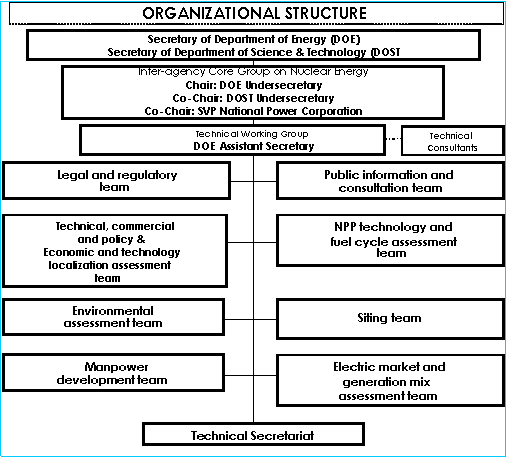 | |
The development of the country’s nuclear power program is now vested under a governmental ad-hoc committee describe in the preceding diagram. By virtue of an inter-departmental order between DOE and DOST, this Inter-agency Core Group on Nuclear Energy was created. Its prime objective is the development, management, setting-up of policies and strategies which will involve nuclear power generation. Part of their mandates is the feasibility study for the possible re-operation of BNPP.
The Committee will act as the interim NEPIO until the Executive Department of the government has issued an order formally creating the NEPIO.
Nuclear power projects would be funded by external financing organization in view of the huge capital cost necessary in putting-up a new plant. Likewise, in case of BNPP recommissioning, external funding may also be required. However, the recommissioning bill has made certain provisions in the electricity tariff as source of funds for BNPP.
New high voltage transmission lines as well as switchyard upgrade is necessary for the recommissioning of BNPP as well as for new power plants.
In 1998, the government has created a committee, the Nuclear Power Steering Committee to provide for the directions on the country’s nuclear power program during this period. It identified numerous possible sites throughout the country as future sites for nuclear power plants as shown in the next figure.
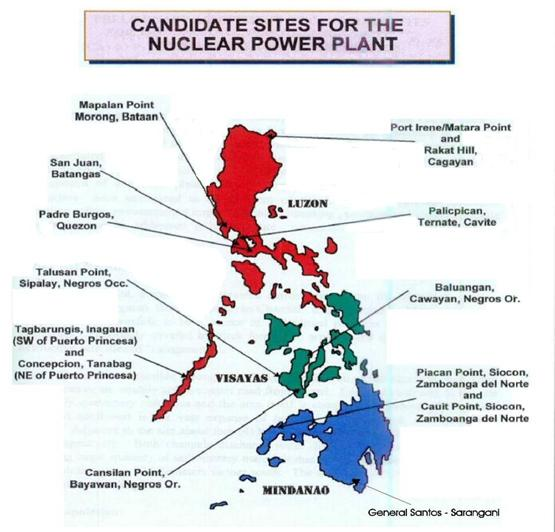
Except for the Bataan site, which would only need updating of data for its Environmental Impact Assessment, all the rest would further require detailed and in-depth site investigation studies and would require preparation of Environmental Impact Assessment. All sites are located near the sea, hence the presence of abundant cooling water from the sea. Likewise, all identified sites are accessible by land transportation and within distance from transmission lines.
On erection/construction of new nuclear power plants, as well as the possible recommissioning of BNPP, the Philippines, through its electric utility corporation, the National Power Corporation will be the main player based on existing laws and because of its vast experience in electric power generation and construction. It has its own engineering, technical services and project management organizations which could be equipped to handle the pre-construction activities, construction stage, operation and maintenance, and decommissioning of a nuclear power plant.
The National Power Corporation will be responsible for the operation of nuclear power plants.
For the decommissioning it will be the National Power Corporation who will implement such activity.
For the country’s first operational nuclear power plant, the front end of the nuclear fuel cycle will be sourced through foreign expertise like what had been done for the BNPP. The BNPP’s fuel supply contract with Westinghouse included the mining and milling, uranium conversion and enrichment, up to fuel fabrication. The same scheme would be arrange for future new plants and to BNPP should it be put into operation.
The new technology for onsite interim storage of spent fuel would be used until firm governmental decision is issued with regards to the future use of the spent fuel. For BNPP, if put into operation, the said storage facility would be set-up.
Reprocessing is at present not among the priorities for the nuclear program, however, should there be decision later on that spent fuel would be reprocessed to convert it into fuel again, then it will be sent to the country where the industry is already in placed or already matured.
On the issue of waste management, the Philippine Nuclear Research Institute, through the technical and financial assistance from the IAEA, has already identified suitable sites within the Philippines as its National Radwaste Repository Center. The Center is being set-up to for the long-term storage of high level wastes coming from hospitals, from the PNRI itself and from nuclear power plants in the future.
At present, the PNRI has the mandates on R & D in the field of nuclear sciences and technology. The country does not have any private institution that caters on this field. However, the pending bill in Congress on the reactivation of BNPP has included provisions for the nuclear R & D. Also, upon embarking to nuclear power, the country’s science and technology industry would certainly add an R & D on nuclear.
Presently the country is not engaged in any advance nuclear technologies development.
On international level, the PNRI acts as the national governmental agency which represents the country as a Member State in the IAEA. PNRI has cooperative agreements in nuclear technology with other 16 Member States of the Regional Cooperative Agreement for Research, Development and Training Related to Nuclear Sciences and Technology for Asia and the Pacific (RCA). The PNRI partners several organizations and entities like the RCA Regional Office (RCARO), Forum for is the lead agency in atomic energy matters in Nuclear Cooperation in Asia (FNCA), Comprehensive Nuclear Test Ban Treaty Organization (CTBTO), and other organizations from Australia, Canada, Japan, Korea, United States and other countries through bilateral agreements/institute-to-institute agreements.
The present government is putting premium on human resource capability building and enhancement as a necessary prelude in considering nuclear power as a long-term energy option. Capability building and enhancement on the various aspects on nuclear energy will involve training of local manpower for the possible introduction of nuclear into the country’s energy system.
Currently the DOE, as the focal governmental institution on the nuclear power program, is leading an inter-agency discussion among the concerned governmental organizations, the academy and private sector to thresh-out the possibilities on re-building local technical capability in nuclear sciences and engineering. Due to retirement of many engineers, new manpower will be recruited and developed.
A Communication Program titled BNPP Communication Plan to be implemented by the NPC’s Corporate Communication is on the drawing board, with the following objectives:
• Raise level of awareness among concerned publics on the benefits of nuclear power in general and revival of the BNPP in particular.
• Address the issues being raised by anti-nuclear and anti-BNPP through various fora.
• Create an environment positive for the acceptance of the revival of the BNPP as a possible option in addressing the lack of generation capacity
The target audience are the general public, media, decision makers and stakeholders like the Philippine Congress, local government units (LGU), church, local media and non-governmental units.
Communication approaches will be through the tri-media approach (TV, print and radio) of press releases, feature stories and interviews, and guestings and personal appearances to relevant talk shows. The other approach is the inter-personal approaches like conduct of forums and symposia with students from major academic institutions and LGUs within the vicinity of BNPP and will include sponsorship tours to the BNPP.
The media to be used will be major broadsheets and magazines, leaflets, posters and flyers, comics and five-minute featurettes and audio visual productions.
The present nuclear regulatory authority is the PNRI which is formerly the Philippine Atomic Energy Commission or PAEC. The PNRI’s bases for nuclear power plant regulations in the USNRC Code of Federal Regulations (CFR).
The licensing procedures involve three main processes, the Provisional Permit Stage where a licensee is issued with Provisional Permit or Limited Work Authority. Next is the Construction Permit Stage where a Construction Permit is issued upon licensee’s satisfaction or compliance to various requirements of the Preliminary Safety Analysis Report. The third stage is the Operating License Stage, where after completion of all conditions precedent, regulatory requirements, licensing of operators, etc., an Operating License is issued where the licensee can then proceed with the fuel core loading and initiate reactor operation for criticality.
CPR Part 3, “Standards for Protection Against Radiation”
CPR Part 4, “Rules and Regulations on the Safe Transport of Radioactive Materials”
CPR Part 7, “Licensing of Atomic Energy Facilities”, based mainly on US NRC documents and IAEA Standards, Codes and Guidelines.
1. Philippine Energy Plan 2007-2014, “Fuelling Philippine Development through Greater Access to Energy”, DOE
2. Philippine Nuclear Research Institute Annual Report 2007
3. PNRI @ 50, “Making Science & Technology Work for You”, PNRI, 2008
4. Philippine Nuclear Power Plant Unit 1 General Information & Technical Features, National Power Corporation, Engineering Division, Feb. 1984
Bilateral Agreements
International treaties, conventions, and agreements signed/ratified (checking necessary):
Cooperation agreements with IAEA in area of NP
Bilateral agreements with other countries or organizations signed/ratified by the country in the field of nuclear power
1. Name: National Power Corporation
Address: NPC Office Building Complex
Quezon Avenue corner BIR Road, Diliman
1100 Quezon City, Philippines
Telephone: +63 2 9213541 to 79
Facsimile: +63 2 9212468
Email: mlmarcelo@napocor.gov.ph
URL: http://www.napocor.gov.ph
Activities: Government Electric Utility Company
2. Name: Department of Energy
Address: Energy Complex, Meritt Road, fort Bonifacio
Taguig City, Philippines
Telephone: +63 2 4792900
Facsimile:
Email: badski@doe.gov.ph
Activities: Governmental Agency for Energy Policies
3. Name: Philippine Nuclear Research Institute
Address: Commonwealth Ave., Diliman
1100 Quezon City, Philippines
Telephone: +63 2 9296010 to 19
Facsimile: +63 2 9201646
URL: http://www.pnri.dost.gov.ph
Activities: Governmental institution for beneficial use of nuclear Science and Technology, including regulations, safeguards, licensing and control of nuclear utilities and materials
Name of report coordinator: MAURO L. MARCELO, JR.
Institution: NATIONAL POWER CORPORATION
Contacts: +63 2 9227848 (landline)
+63 928 5019857 (mobile)